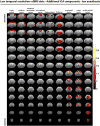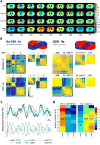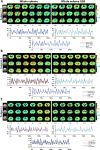Dynamic resting state fMRI analysis in mice reveals a set of Quasi-Periodic Patterns and illustrates their relationship with the global signal
- PMID: 29454935
- PMCID: PMC6093802
- DOI: 10.1016/j.neuroimage.2018.01.075
Dynamic resting state fMRI analysis in mice reveals a set of Quasi-Periodic Patterns and illustrates their relationship with the global signal
Abstract
Time-resolved 'dynamic' over whole-period 'static' analysis of low frequency (LF) blood-oxygen level dependent (BOLD) fluctuations provides many additional insights into the macroscale organization and dynamics of neural activity. Although there has been considerable advancement in the development of mouse resting state fMRI (rsfMRI), very little remains known about its dynamic repertoire. Here, we report for the first time the detection of a set of recurring spatiotemporal Quasi-Periodic Patterns (QPPs) in mice, which show spatial similarity with known resting state networks. Furthermore, we establish a close relationship between several of these patterns and the global signal. We acquired high temporal rsfMRI scans under conditions of low (LA) and high (HA) medetomidine-isoflurane anesthesia. We then employed the algorithm developed by Majeed et al. (2011), previously applied in rats and humans, which detects and averages recurring spatiotemporal patterns in the LF BOLD signal. One type of observed patterns in mice was highly similar to those originally observed in rats, displaying propagation from lateral to medial cortical regions, which suggestively pertain to a mouse Task-Positive like network (TPN) and Default Mode like network (DMN). Other QPPs showed more widespread or striatal involvement and were no longer detected after global signal regression (GSR). This was further supported by diminished detection of subcortical dynamics after GSR, with cortical dynamics predominating. Observed QPPs were both qualitatively and quantitatively determined to be consistent across both anesthesia conditions, with GSR producing the same outcome. Under LA, QPPs were consistently detected at both group and single subject level. Under HA, consistency and pattern occurrence rate decreased, whilst cortical contribution to the patterns diminished. These findings confirm the robustness of QPPs across species and demonstrate a new approach to study mouse LF BOLD spatiotemporal dynamics and mechanisms underlying functional connectivity. The observed impact of GSR on QPPs might help better comprehend its controversial role in conventional resting state studies. Finally, consistent detection of QPPs at single subject level under LA promises a step forward towards more reliable mouse rsfMRI and further confirms the importance of selecting an optimal anesthesia regime.
Keywords: Default mode network; Dynamic rsfMRI; Global signal regression; Medetomidine/isoflurane anesthesia; Mouse; Quasi-periodic pattern (QPP).
Copyright © 2018 Elsevier Inc. All rights reserved.
Figures









Similar articles
-
Resting State fMRI in Mice Reveals Anesthesia Specific Signatures of Brain Functional Networks and Their Interactions.Front Neural Circuits. 2017 Feb 3;11:5. doi: 10.3389/fncir.2017.00005. eCollection 2017. Front Neural Circuits. 2017. PMID: 28217085 Free PMC article.
-
Quasi-periodic patterns of intrinsic brain activity in individuals and their relationship to global signal.Neuroimage. 2018 Feb 15;167:297-308. doi: 10.1016/j.neuroimage.2017.11.043. Epub 2017 Nov 22. Neuroimage. 2018. PMID: 29175200 Free PMC article.
-
Quasi-periodic patterns contribute to functional connectivity in the brain.Neuroimage. 2019 May 1;191:193-204. doi: 10.1016/j.neuroimage.2019.01.076. Epub 2019 Feb 10. Neuroimage. 2019. PMID: 30753928 Free PMC article.
-
[Resting state functional MRI of the brain].Nervenarzt. 2014 Jun;85(6):690-700. doi: 10.1007/s00115-014-4013-y. Nervenarzt. 2014. PMID: 24849117 Review. German.
-
Mapping cognitive and emotional networks in neurosurgical patients using resting-state functional magnetic resonance imaging.Neurosurg Focus. 2020 Feb 1;48(2):E9. doi: 10.3171/2019.11.FOCUS19773. Neurosurg Focus. 2020. PMID: 32006946 Free PMC article. Review.
Cited by
-
Bring the Noise: Reconceptualizing Spontaneous Neural Activity.Trends Cogn Sci. 2020 Sep;24(9):734-746. doi: 10.1016/j.tics.2020.06.003. Epub 2020 Jun 27. Trends Cogn Sci. 2020. PMID: 32600967 Free PMC article. Review.
-
Functional Brain Connectivity Revealed by Sparse Coding of Large-Scale Local Field Potential Dynamics.Brain Topogr. 2019 Mar;32(2):255-270. doi: 10.1007/s10548-018-0682-3. Epub 2018 Oct 19. Brain Topogr. 2019. PMID: 30341589 Free PMC article.
-
Monitoring Neuronal Network Disturbances of Brain Diseases: A Preclinical MRI Approach in the Rodent Brain.Front Cell Neurosci. 2022 Jan 3;15:815552. doi: 10.3389/fncel.2021.815552. eCollection 2021. Front Cell Neurosci. 2022. PMID: 35046778 Free PMC article. Review.
-
Quasi-Periodic Patterns of Neural Activity improve Classification of Alzheimer's Disease in Mice.Sci Rep. 2018 Jul 3;8(1):10024. doi: 10.1038/s41598-018-28237-9. Sci Rep. 2018. PMID: 29968786 Free PMC article.
-
Functional network antagonism and consciousness.Netw Neurosci. 2022 Oct 1;6(4):998-1009. doi: 10.1162/netn_a_00244. eCollection 2022. Netw Neurosci. 2022. PMID: 38800457 Free PMC article.
References
-
- Abbas A, Majeed W, Thompson GJ, Keilholz SD. Phase of quasiperiodic pattern predicts performance on vigilance task in humans. Proc Int Soc Magn Reson Med. 2016:1192.
-
- Anderson JS, Ferguson MA, Lopez-larson M, Yurgelun-todd D. Topographic maps of multisensory attention. Proc Nat Acad Sci. 2010;107 doi: 10.1073/pnas.1011616107/-/DCSupplemental. www.pnas.org/cgi/doi/10.1073/pnas.1011616107 https://doi.org/10.1073/pnas.1011616107/-/DCSupplemental . . www.pnas.org/cgi/doi/10.1073/pnas.1011616107. - DOI - DOI - PMC - PubMed
Publication types
MeSH terms
Substances
Grants and funding
LinkOut - more resources
Full Text Sources
Other Literature Sources
Research Materials
Miscellaneous

